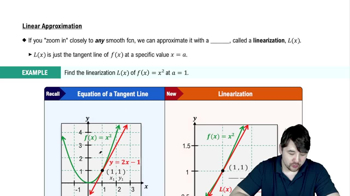Table of contents
- 0. Functions7h 52m
- Introduction to Functions16m
- Piecewise Functions10m
- Properties of Functions9m
- Common Functions1h 8m
- Transformations5m
- Combining Functions27m
- Exponent rules32m
- Exponential Functions28m
- Logarithmic Functions24m
- Properties of Logarithms34m
- Exponential & Logarithmic Equations35m
- Introduction to Trigonometric Functions38m
- Graphs of Trigonometric Functions44m
- Trigonometric Identities47m
- Inverse Trigonometric Functions48m
- 1. Limits and Continuity2h 2m
- 2. Intro to Derivatives1h 33m
- 3. Techniques of Differentiation3h 18m
- 4. Applications of Derivatives2h 38m
- 5. Graphical Applications of Derivatives6h 2m
- 6. Derivatives of Inverse, Exponential, & Logarithmic Functions2h 37m
- 7. Antiderivatives & Indefinite Integrals1h 26m
- 8. Definite Integrals4h 44m
- 9. Graphical Applications of Integrals2h 27m
- 10. Physics Applications of Integrals 2h 22m
4. Applications of Derivatives
Linearization
Problem 21
Textbook Question
21–32. Mean Value Theorem Consider the following functions on the given interval [a, b].
a. Determine whether the Mean Value Theorem applies to the following functions on the given interval [a, b].
b. If so, find the point(s) that are guaranteed to exist by the Mean Value Theorem.
ƒ(x) = 7 -x² ; [-1; 2]
 Verified step by step guidance
Verified step by step guidance1
Step 1: Verify the conditions of the Mean Value Theorem (MVT). The MVT states that if a function f(x) is continuous on the closed interval [a, b] and differentiable on the open interval (a, b), then there exists at least one point c in (a, b) such that f'(c) = (f(b) - f(a)) / (b - a).
Step 2: Check continuity of f(x) = 7 - x² on the interval [-1, 2]. Since f(x) is a polynomial, it is continuous everywhere, including on the interval [-1, 2].
Step 3: Check differentiability of f(x) = 7 - x² on the interval (-1, 2). Again, since f(x) is a polynomial, it is differentiable everywhere, including on the interval (-1, 2).
Step 4: Calculate the derivative f'(x). For f(x) = 7 - x², the derivative is f'(x) = -2x.
Step 5: Use the MVT formula to find the point c. Calculate f(b) and f(a): f(2) = 7 - 2² = 3 and f(-1) = 7 - (-1)² = 6. Then, compute (f(b) - f(a)) / (b - a) = (3 - 6) / (2 - (-1)) = -1. Set f'(c) = -2c equal to -1 and solve for c.
 Verified video answer for a similar problem:
Verified video answer for a similar problem:This video solution was recommended by our tutors as helpful for the problem above
Video duration:
4mPlay a video:
Was this helpful?
Key Concepts
Here are the essential concepts you must grasp in order to answer the question correctly.
Mean Value Theorem (MVT)
The Mean Value Theorem states that if a function is continuous on a closed interval [a, b] and differentiable on the open interval (a, b), then there exists at least one point c in (a, b) such that the derivative at that point equals the average rate of change of the function over the interval. This theorem is fundamental in connecting the behavior of a function to its derivative.
Recommended video:

Fundamental Theorem of Calculus Part 1
Continuity and Differentiability
For the Mean Value Theorem to apply, the function must be continuous on the closed interval [a, b] and differentiable on the open interval (a, b). Continuity ensures that there are no breaks or jumps in the function, while differentiability means that the function has a defined slope at every point in the interval, allowing for the application of the theorem.
Recommended video:

Intro to Continuity
Finding c using MVT
Once it is established that the Mean Value Theorem applies, the next step is to find the point c where the instantaneous rate of change (the derivative) equals the average rate of change over the interval. This involves calculating the derivative of the function and setting it equal to the average rate of change, which is determined by the formula (f(b) - f(a)) / (b - a).
Recommended video:

Finding Limits by Direct Substitution
Related Videos
Related Practice




